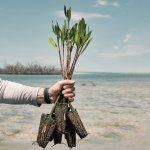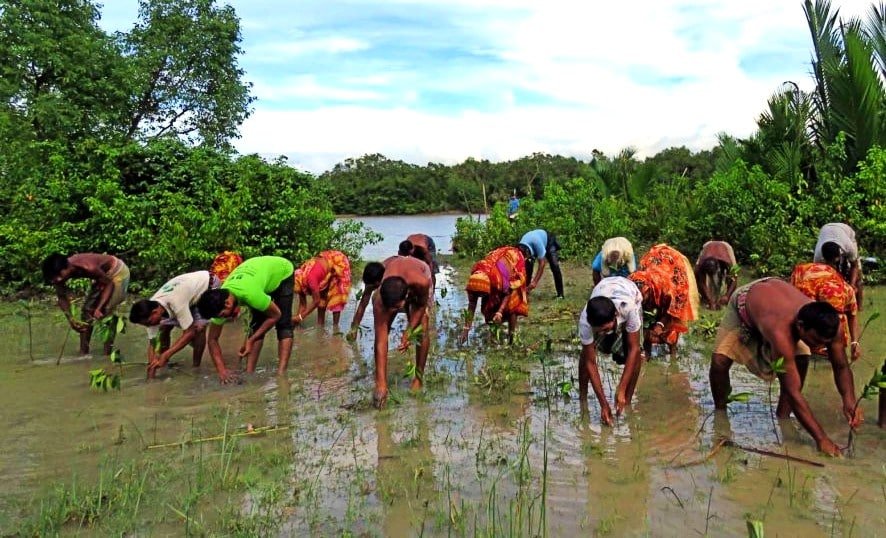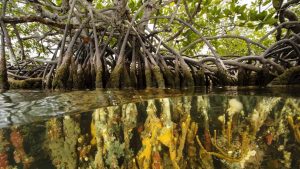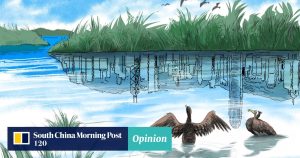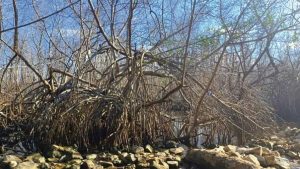Oman mangrove project targets emissions & carbon credit benefits.
The government of Oman has been restoring mangroves quickly, a valuable natural resource, not just for their essential role in the global environmental ecosystem but also for their integral part in absorbing carbon. The goal is to eliminate planet-warming emissions while generating $150 million economic benefits through carbon credits. source=carboncredits.com
6,000 years ago, mangroves were widespread in Oman but only one species remains today because of climate change. So the country aims to restore the coastal forest of these carbon-busting trees.
The Richest Carbon Sink in the World
Mangroves are highly effective carbon sinks, playing a crucial role in sequestering and storing atmospheric carbon dioxide. They possess several mechanisms that contribute to their carbon sequestration ability, including photosynthesis, sediment trapping, slow decomposition, and peat formation. Moreover, mangrove habitats can remove CO2 from the atmosphere faster than forests and store it in the soil and sediment for longer periods. A study by the University of Bonn revealed that climatic changes account for the collapse of coastal ecosystems in Oman. source=carboncredits.com
The Arab nation is home to only a single species of mangrove tree, the Avicennia Marina, found along the coastline stretching from North al Batinah to Dhofar. This area covered by mangroves expands around 1,000 hectares. Oman has then become the Gulf’s center for mangrove restoration and preservation. The Middle East country, through its Environment Authority (EA), inked a deal with MSA Green Projects last month to launch the Oman Blue Carbon. Their project seeks to cultivate 100 million mangrove trees in the country. The initiative aligns with the Sultanate’s National Zero Carbon Strategy 2050, outlining its goal to reach net zero emissions. source=carboncredits.com
Oman’s Projected Decarbonization Efforts to 2050
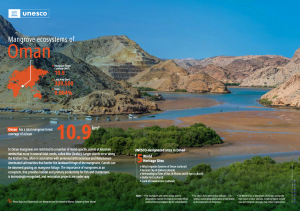
Badr bin Saif Al Busaidi, the EA representative, said that their restoration efforts were a success. She further noted that up to 80 tons of CO2 per hectare can be sequestered by above-ground biomass in Al-Qurm. An environmental scientist said that “mangroves are the richest carbon sink in the world.” They’re known as one of the nature-based solutions that corporations support to combat climate change. The $150 Million Carbon Credit Benefits
The Oman Blue Carbon project marks the first initiative aiming to produce carbon credits through growing mangroves. So far, the Gulf nation has planted more than 3.5 million seeds of mangroves over the past 2 years. This includes a record 2 million trees this year. Twenty years ago, there wasn’t a single mangrove standing in Al-Sawadi creek. But now it’s a forest stretching over 4 kilometers with 88 hectares of hangover cover. The mangrove restoration project has developed gradually, inspired by the late ruler Sultan Qaboos bin Said, a renowned conservationist. The conservationists initially relied on nurseries where they grow seedlings for transfer to coastal areas. They’re using a direct, targeted planting approach in restoring the coastal habitat. Oman’s contract with MSA Green Projects to grow 100 million trees over 4 years would remove 14 million metric tons of CO2. This, in turn, would give the country the chance to earn $150 million in carbon credit benefits. source=carboncredits.com
Each carbon credit represents one metric ton of reduced or removed CO2 from the atmosphere. As part of their agreement, the Al Wusta governorate will transform 20,000 hectares of coastal land into mangrove habitats. The corresponding carbon credits the initiative generates can be used by companies seeking to offset their carbon emissions. The amount of carbon offset credits the project produces would be measured against Oman’s baseline emissions – 90 metric tons in 2021. source=carboncredits.com
Winning the War with Nature
The minor oil producer, compared with its neighbours Saudi Arabia and United Arab Emirates, is moving fast in this mangrove restoration project. Highlighting the importance of their swift move, one of the conservationists involved in the project said: “We are living what we can call a war with nature because of climate change. If we don’t take action, we will lose these natural resources.” The Sultanate is also developing its green hydrogen production via Hydrom, aiming to produce 1 million tonnes by 2030. That target moves up to over 8 million tons by 2050. This ambitious goal is also part of Oman’s clean energy transition and net zero strategies. source=carboncredits.com
Oman’s ambitious mangrove restoration project not only signifies a critical step in combating climate change but also presents a lucrative opportunity, positioning the country as a key player in the global carbon credit market. source=carboncredits.com
VIDEO: In a muddy wetland in Oman's capital, environmental scientist Zakiya al-Afifi measures the bark of a mangrove tree and says the Al-Qurm forest's 80 protected hectares (197 acres) of mangroves could lock away thousands of tons of CO2. pic.twitter.com/AtYF8nJpVP
— AFP News Agency (@AFP) November 3, 2023
